This is Section 7 of a series on the topic of deriving impact from universities in the 21st century, authored by Nicholas Mathiou, Director of Griffith Enterprise.

“Knowledge is of two kinds. We know a subject ourselves, or we know where we can find information on it.”
― Samuel Johnson
7. Purposeful Engagement
Introduction
Determining the best ways to maximise societal impact is challenging and for universities operating with constrained resources in increasingly dynamic internal and external environments, this challenge becomes even more difficult. Setting organisational direction in such a climate requires universities to thoroughly understand their underlying assets and the potential societal impact they can deliver. It behoves any university, therefore, to ask itself: ‘What are we doing here? Where exactly are we going with this?’
It is an important process in navigating the way forward that calls for strong decisions based on reliable information which has been garnered astutely and efficiently. It also requires the right judgment so that the correct opportunities are prioritised and resourced accordingly. Enhanced knowledge of the environment and climate outside the university domain must be accessed and accumulated in deciding on the best partners to shape enduring and productive partnerships to drive societal benefit. None of this can be achieved to the requisite level without engagement, the activities through which universities ensure the correct information is at hand at crunch moments, so that the right opportunity is embraced at the right time, in tandem with exactly the right partner.
It all starts with simply asking what is our objective, why are we engaging, and what are the outcomes of the various engagement activities we seek or pursue? Acts of engagement on the part of a university must be purposeful and brought about through suitable, supportive but differing avenues which will be explored in the next section. In this section of the series, we unpack the concept of purposeful engagement, first of all by shining a light on the very reasons to engage.
Why purposeful engagement is important
Universities seeking to maximise societal impact invariably have an outward focus on major societal needs, and shape education programs and research outcomes to address those needs. They also have the ability to work directly or in partnership with external organisations and key stakeholders to ensure socio-economic benefits materialise from those programs and outcomes.
As a result, universities are presented with many different underlying reasons not just to engage but to engage with purpose. These include: (i) garnering market intelligence and insights; (ii) building relationships and networks; (iii) creating buy-in through shared vision; (iv) fostering active support from key stakeholders; (v) structuring flexible and sustainable partnerships; and (vi) working with partners to ensure the most people in need have access to programs, products and services.
This diversity of reasons, coupled with the breadth of activities across a university, can make the natures and scope of engagement seem astonishingly complex and lead to disparate activities which are often ineffectual and can dilute overall effort. It is important, therefore, to appreciate the overarching ‘objective’ of engagement from the outset. For example, is the major objective (a) to set organisational direction; (b) to curate opportunities; (c) to shape enduring partnerships; or (d) to work with partners to deliver outcomes?
When the objective is clear, the ‘purpose’ can be determined and the purpose of engaging, in turn, frames the questions to be answered and sharpens the ‘focus’ of engagement activities required to answer them. This is an important step in progressing from reactionary to purposeful. By bonding the purpose of engaging with the foci of engagement activities, far more effective decisions and actions may then be taken – converting otherwise disparate engagement activities into ‘purposeful engagement’ (or discarding them).
Approaching engagement purposefully

Nature of purposeful engagement
In sections 2-5 of this series, we explored the ways universities can set organisational direction to maximise societal benefits, while in section 6 we determined that to achieve organisational direction, universities need to be critically proficient at curating opportunities, shaping partnerships and delivering outcomes. These four key objectives will now be utilised to unpack the nature of purposeful engagement.
Objective: Set organisational direction
If setting organisational direction is the objective, the key purpose of engagement is to ‘inform’ decisions on direction with relevant and accurate information about both internal and external environments. Internal engagement helps to ‘examine’ a university’s resource profile (e.g. strengths, weaknesses, resource gaps); external engagement is used to ‘seek’ major trends, attractive markets, paths-to-markets and competitive positions. To effectively ‘inform’ decisions, a university must first ‘examine’ internally and ‘seek’ externally.
Internal and external engagement activities must also operate in tandem around a given purpose. If the purpose of engaging is to establish our ‘North Stars’, there are various underlying questions that can only be answered through both internal and external engagement activities. Similarly, if the purpose of engaging is to find out what is our opportunity spectrum, another set of different questions need to be addressed by engagement activities both internal and external (along with the utilisation of various engagement ‘channels’ to be discussed in the next section of the series).
This framing of the required engagement activities around a purpose (illustrated in the table below) converts otherwise disparate activities into ‘purposeful’ engagement. This theme remains a ‘constant’ throughout the following illustrations and aspects of engagement.
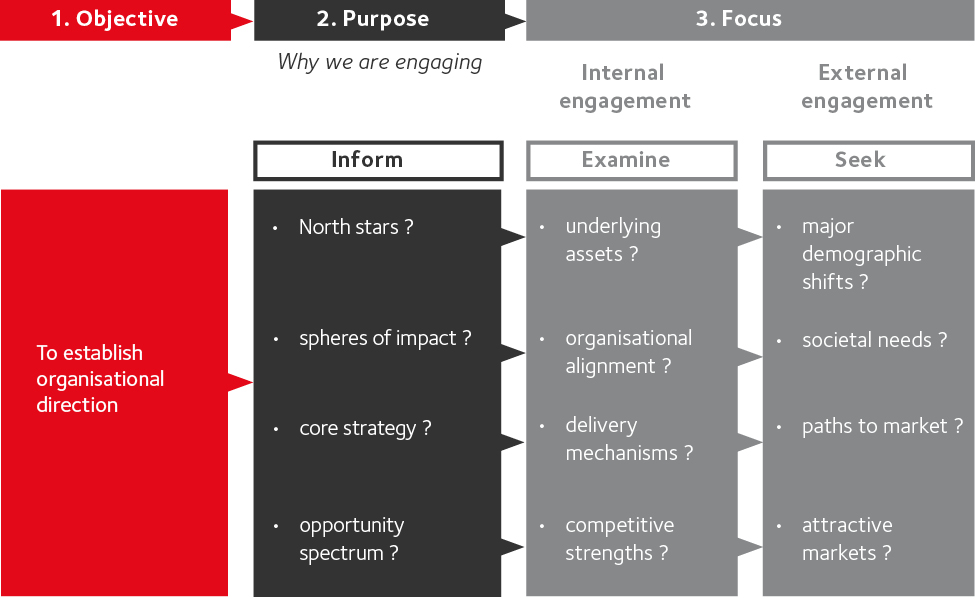
Objective: Curate opportunities
For universities to successfully derive impact, they must become proficient at curating opportunities. Here, the purpose of engagement shifts from “inform” (to determine organisational direction) to “enlist”; viz. the sourcing and design of offerings to facilitate uptake and utilisation. In essence, the engagement activities associated with curating opportunities are a starting point for the implementation of a university’s organisational direction as they support the development of a portfolio of tangible education programs and research outcomes that can address major societal needs.
The focus of external engagement is to “understand” the problems to be solved, while the focus of internal engagement is to “activate” the orientation and deployment of resources toward providing solutions to those problems. The following table illustrates purposeful engagement in the context of curating opportunities:
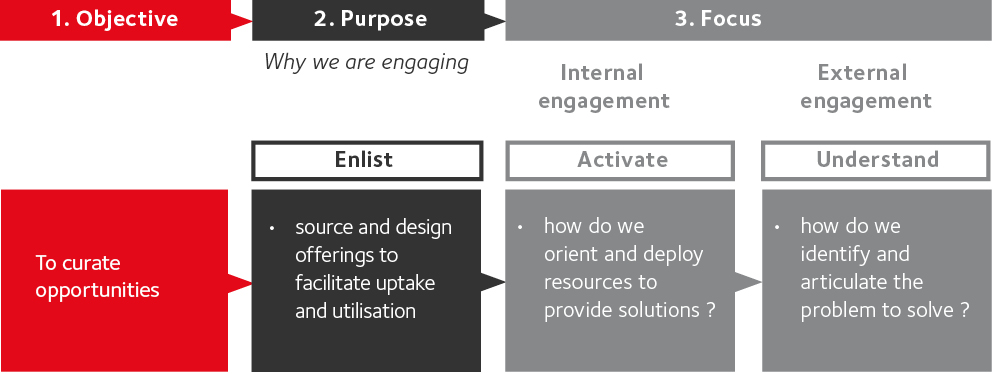
Internal and external engagement activities are inextricably linked. Undertaking external engagement where a university has capability (and competitive position) increases likelihood of impactful opportunities. Similarly, undertaking internal engagement activities with knowledge of the external environment (including competitive position) can lead to more effective resource allocation and also be more likely to curate opportunities.
Objective: Shape partnerships
To ensure the most people get the most benefit from education programs and research outcomes, universities must be proficient at shaping enduring partnerships. Here, the purpose of engagement shifts from “enlist” (viz., to curate opportunities) to “structure”; viz. shaping mutually beneficial and sustainable partnerships. Internal engagement activities are required to “craft” tangible offerings, which involves activities like determining university approaches to solving problems, identifying the best combination of resources required to solve problems, assembling offerings and determining the appropriate partnership terms. External engagement activities are required to “attract” the best partners. This involves engagement activities like exploring ways to work together, and the process of ‘due diligence’ in identifying and selecting the best partners. Also relevant in this context is the shaping and justifying of offerings, and negotiating, documenting and entering partnerships.[1]
Again, internal and external engagement activities are galvanised around purpose (here, described as “structure”) and are fundamental to successfully shaping the partnerships required to derive societal benefits. The following table illustrates purposeful engagement in the context of shaping partnerships:
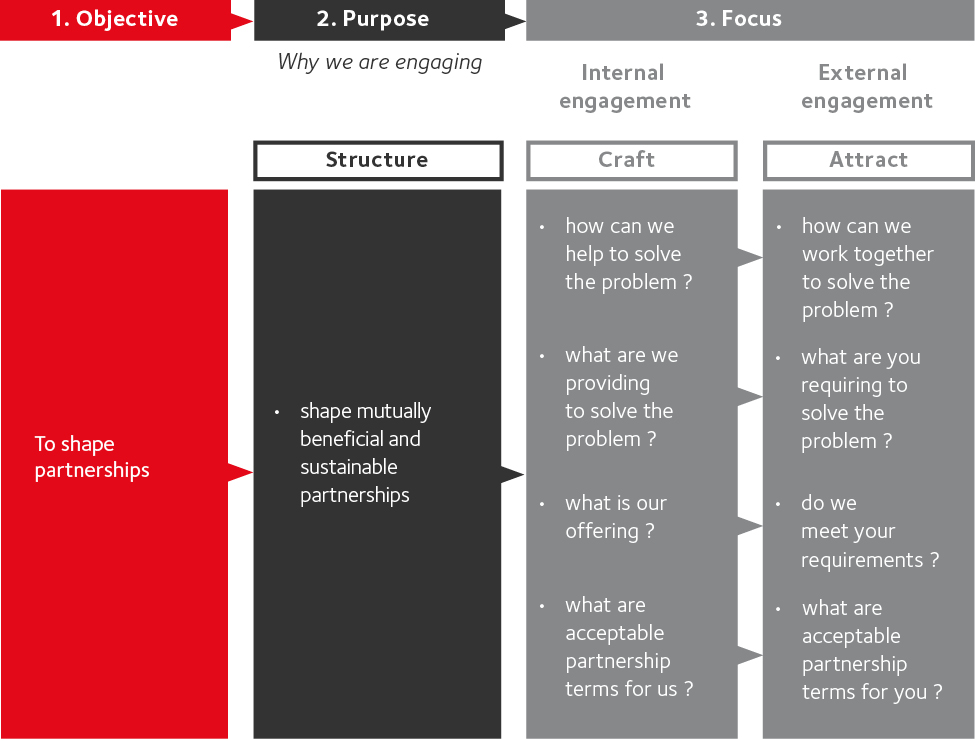
In this case, engagement activities support the business development initiatives required to ensure tangible education programs and research outcomes are capable of delivery to students and organisations. The engagement activities support the ‘entering into’ of the portfolio of partnerships required for delivery.
Objective: Deliver outcomes
It is through the successful delivery of solutions to problems that societal outcomes materialise. Universities must therefore also be proficient at delivering, along with their partners, the solutions (whether that be tangible education programs or research outcomes). Here, the purpose of engagement shifts from “structure” to “perform”; viz. ensuring that the most in need get benefits through provision of the solution. Internal engagement is focused on “managing” to ensure the successful delivery of the solution. External engagement is required to “leverage” outcomes; not only ensuring delivery, but often assisting the partnership to scale so that more people in need of the solution are reached.
Again, the matching of internal and external engagement to the purpose (viz., “perform”) is fundamental to successfully deriving societal benefits from universities. The following table illustrates purposeful engagement in the context of delivering outcomes:
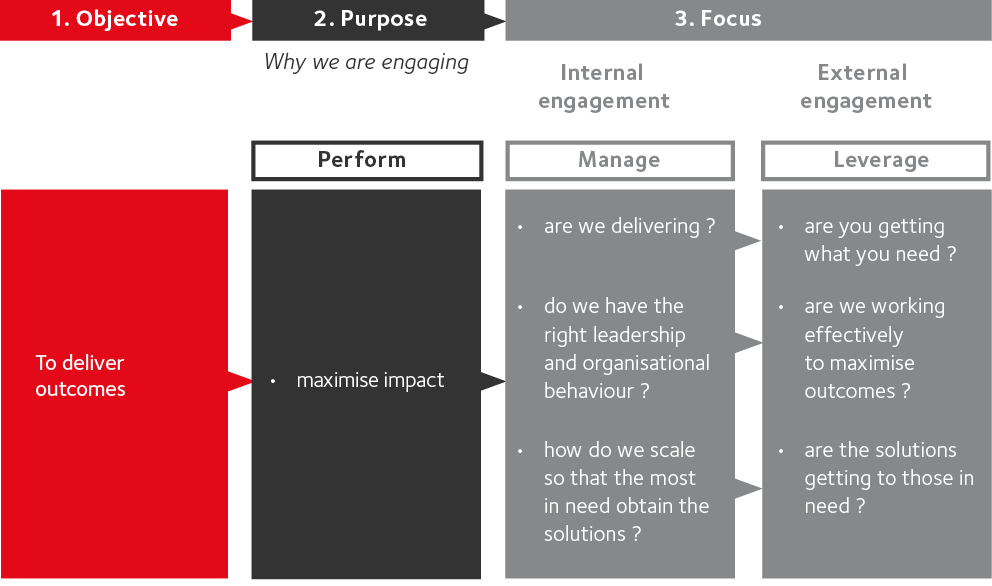
Establishing purposeful engagement
Through purposeful engagement, universities can best set organisational direction and also be proficient at curating opportunities, shaping enduring partnerships and delivering great socio-economic impact. In conclusion, therefore, continually considering the following three questions helps universities engage purposefully:
Question 1: What is our objective? (To establish organisational direction, curate opportunities, shape partnerships or deliver outcomes from new or existing partnerships?)
Question 2: What is the purpose of our engagement activities?
Question 3: What is the focus of our internal and external engagement?
On answering these questions, a university must also ask itself if it has the support structures in place for engagement activities to happen with the required purpose, and it is to these that we turn in the next section of the series, Channels of Engagement.
Read the previous article from this series.
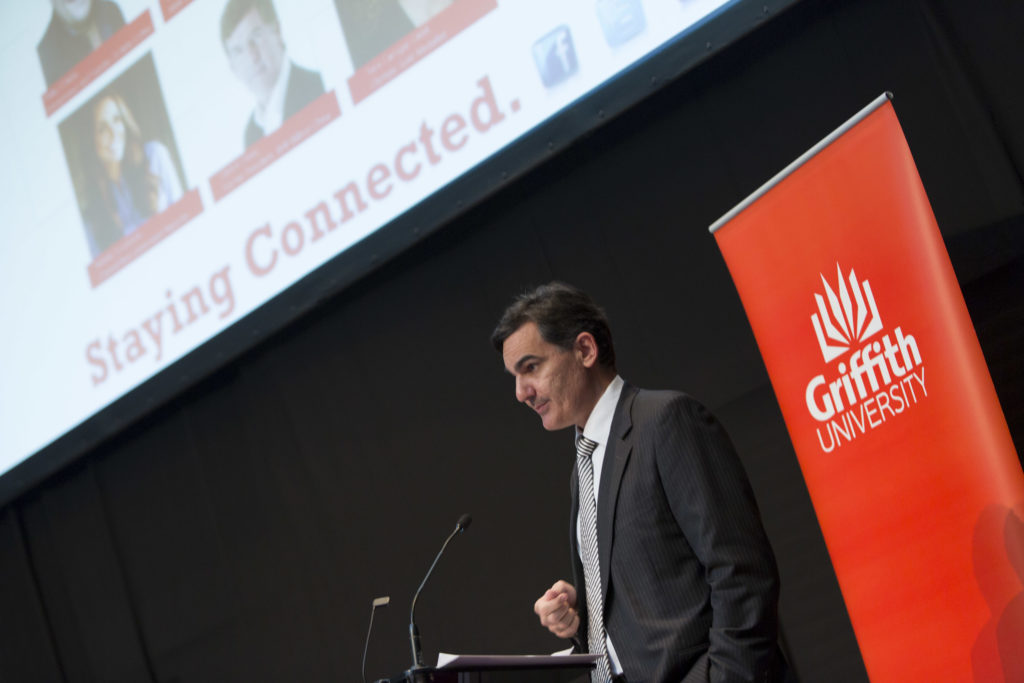
ABOUT THE AUTHOR: Nicholas Mathiou is Director of Griffith Enterprise, the innovation and enterprise office of Griffith University. He has extensive commercial experience, having established and grown innovation-based businesses and organisations. He is driven by an ambition to see great social dividends emerge through university-based innovation. He has a deep understanding of the unique challenges involved in advancing innovations within complex organisations and in dynamic environments.
[1] The nature of the exchanges between universities and partners, and the interconnected value propositions that must be established, are integral to establishing enduring partnerships (and will be the subject of another series).
Introduction image credit: photo by Adlan on Unsplash


